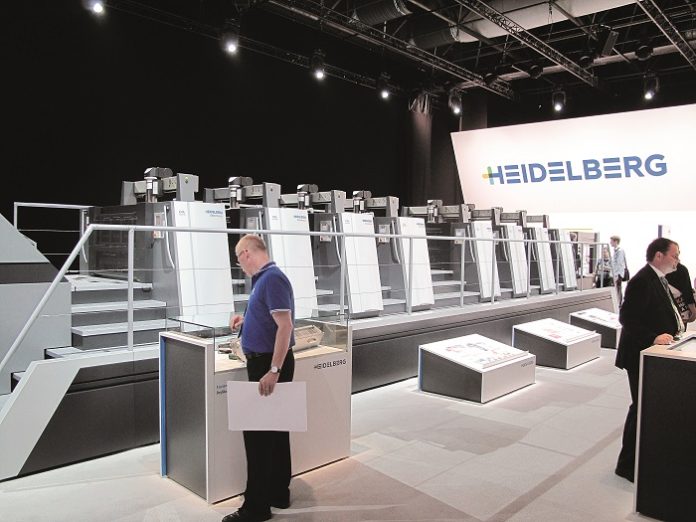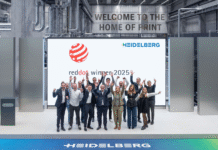The offset market in India is pretty robust at the moment. While 2015 was a booming period for the industry, with a record number of sheetfed presses being installed, for Heidelberg India it was more of an average year. Amidst tough competition from its Japanese competitors, it was not easy to refocus on one of the most value-oriented and price-conscious markets of the world—India. This year, Heidelberg India seems to be on a comeback trail though. Indian Printer & Publisher spoke to Peter Rego, general manager at Heidelberg India on the company’s performance this year and his thoughts on the print industry at the moment.
Peter Rego says, “Our ‘Push-toStop’ technology introduced at drupa 2016 set the foundation for 2016 becoming a fantastic year for Heidelberg India. We will be installing a double-digit number of long A1-format 6- or 7-color packaging presses with coaters and UV, and more than 14 presses for commercial printing. It has been the best year since 2011, as we are beginning to see a real turnaround in the industry. We did see some Japanese presses coming into India until the beginning of the current financial year, supported by a favorable exchange rate and availability of double-demi print format. This served as a wake-up call for us, and the best time to rethink your competitive strength is when you are faced with such challenges. This year the trend has shifted again to German presses, and Heidelberg India will be installing 150+ brand new sheetfed units, the highest number in the country. Secondly, dealing directly with Heidelberg India, which is fully owned by Heidelberger Druckmaschinen AG, gives our customers peace of mind and satisfaction. Similarly, we ensure that the customer gets the best aftersales service and support from our 63 trained and dedicated engineers across India.”
Rego feels that the Indian market is moving in a positive direction. “The need for automation is growing, as cost of labor is on the rise. Similarly, the cost of land and building are also growing, and power is certainly more expensive. Consolidation along with modernization is the need of the hour. We foresee organized segments with automation and connectivity to thrive, while print shops lacking in technology will find it hard to swim against the tide,” he says.
Rego believes that the dynamics of the Indian market is evolving at the moment. He says, “Packaging and labeling are growing at around 15%, while commercial printing is getting fiercely competitive. To gain that competitive edge and better future in print, we see three viable options for commercial printers today—invest in technology to gain competitive differentiation; expand footprint into packaging; and engage in publications or book printing with a used 8-color SM 102-8-P press. The good news is that book publishing is back and is definitely here to stay. The novelty of eBooks is wearing off and readers are once again craving for the touch, feel and smellingthe-paper experience. This trend is specially visible in the Western countries including USA.”
According to Rego, packaging customers are looking at increased automation, faster make-readies, lesser waste as each board saved is money earned, fewer processes and more processes inline, leaner inventories, payment terms less than 30 days for NWC (networking capital) and cash-on-hand. “Despite the confusion over the environmental and recycling issues related to Met Pet and laminated boards, about 15% growth is seen in Met Pet and UV jobs. If laminated boards cause serious issues, double coaters will supplant boards for special inline applications.”
In the Indian economy and environment, ‘juggad’ is something which we dabble with very often. While we are aware that digital and offset complement each other and have coexisted for a long time, we cannot ignore the distinct capabilities and limitations of either, says Rego. “Offset cannot do VDP (variable data printing), and digital cannot print 500 sheets and still be cheaper. Both have their own niche and markets. In an emerging market like India, which is characterized by huge volumes, both digital and offset will be around for many more years to come. Though many digital players, including Heidelberg, have showcased some exceptional machines at drupa, at the end of the day, everything boils down to the cost per sheet. Here, digital would have met its match. In the commercial sector, we observe digital and commercial offset being merged to offer customized solutions. In the case of wedding albums, digital rules. Competing with offset for long-run packaging jobs can get pretty rough for digital though,” Rego states.
For print businesses to flourish in the future, a quicker roll-out of automation and lesser dependence on manual labor would be the better route for business to take, believes Rego. “Digitization or Industry 4.0 will begin to significantly transform our industry, making it imperative for the printers to find ways to benefit from the digitization wave. It makes any enterprise leaner, and improves the chances of staying ahead of competition. The bigger and technologically advanced print shops will take a larger share of the pie.”
Rego feels that it is show time for the Indian print industry. “In the next 7 to 10 years, Asia in general, and an emerging market like ours in particular, will dominate the global printing turf. The Indian print industry is buzzing with excitement, sending clear and positive vibes of growth and investment. With the government’s ‘Make in India’ policy in take-off mode, the scenario will get only better from here,” concludes Rego.


















